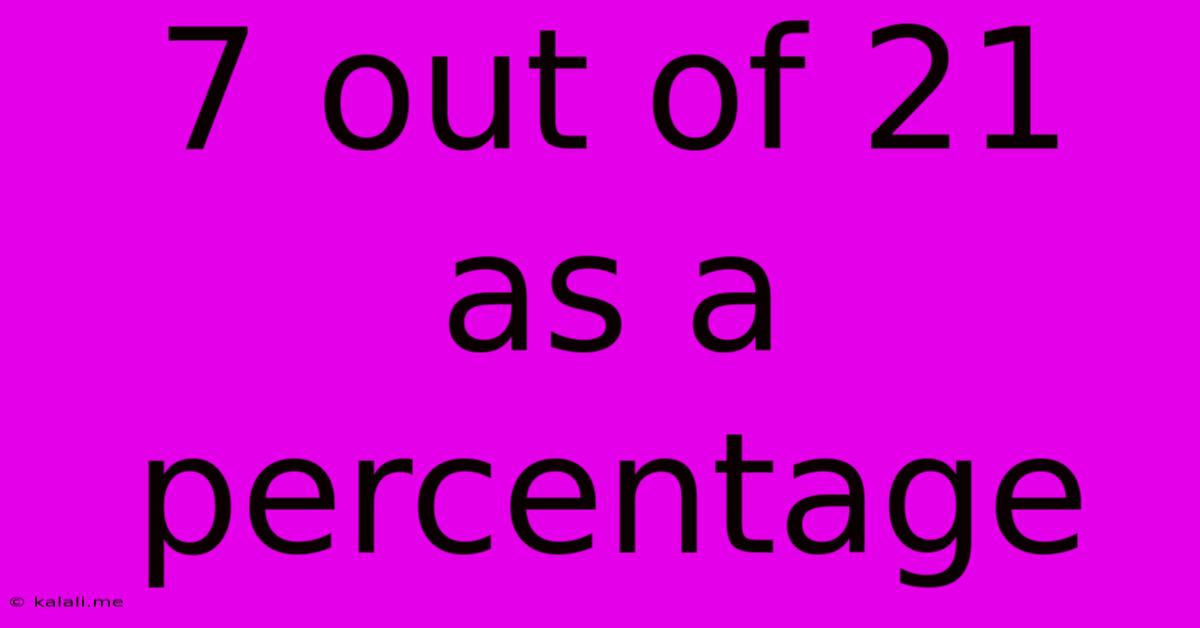7 Out Of 21 As A Percentage
Kalali
May 09, 2025 · 3 min read

Table of Contents
7 out of 21 as a Percentage: A Simple Guide
So, you need to figure out what 7 out of 21 represents as a percentage? This is a common calculation used in various situations, from calculating grades to understanding sales figures. This guide will walk you through the process, providing a clear explanation and demonstrating different methods. Understanding this simple percentage calculation can be a valuable skill in everyday life and professional settings.
Understanding the Basics of Percentages
Before we dive into the calculation, let's briefly review what percentages are. A percentage is a fraction or ratio expressed as a number out of 100. The symbol "%" is used to denote percentages. For example, 50% means 50 out of 100, or one-half.
Method 1: Using a Fraction and Decimal Conversion
The most straightforward method is to convert the fraction 7/21 into a decimal and then into a percentage.
- Formulate the Fraction: Express the problem as a fraction: 7/21.
- Simplify the Fraction: Notice that both the numerator (7) and denominator (21) are divisible by 7. Simplifying the fraction, we get 1/3.
- Convert to Decimal: Divide the numerator (1) by the denominator (3): 1 ÷ 3 = 0.333... (This is a recurring decimal).
- Convert to Percentage: Multiply the decimal by 100: 0.333... × 100 ≈ 33.33%.
Therefore, 7 out of 21 is approximately 33.33%.
Method 2: Direct Percentage Calculation
Alternatively, you can directly calculate the percentage using the following formula:
(Part / Whole) x 100%
In this case:
(7 / 21) x 100% = 0.333... x 100% ≈ 33.33%
This method bypasses the need for simplifying the fraction initially, arriving at the same result.
Method 3: Using a Calculator
Most calculators have a percentage function. Simply enter 7 ÷ 21 and then multiply by 100 to get the percentage. This is the quickest and easiest method, especially for more complex calculations.
Rounding Percentages
As you've seen in our calculations, we often encounter recurring decimals when dealing with percentages. It's common practice to round these decimals to a certain number of decimal places. In this example, we rounded to two decimal places (33.33%), but depending on the context, you might round to one decimal place (33.3%) or even a whole number (33%). Always consider the level of precision required for your specific situation.
Practical Applications
Understanding how to calculate percentages like "7 out of 21" is incredibly useful in many real-world scenarios. Here are just a few examples:
- Grade Calculations: If you answered 7 questions correctly out of 21 on a test, your score would be approximately 33.33%.
- Sales Performance: If a salesperson made 7 sales out of 21 potential clients, their conversion rate would be approximately 33.33%.
- Data Analysis: In various data analysis tasks, calculating percentages is essential for understanding proportions and trends.
By mastering this simple calculation, you'll enhance your ability to interpret data and solve various percentage-related problems efficiently. Remember to choose the method that best suits your needs and always pay attention to the level of precision required for your result.
Latest Posts
Latest Posts
-
1 And Half Cups In Oz
May 09, 2025
-
A Change In A Sequence Of Dna Is Called A
May 09, 2025
-
How Much Is 76 Cm In Inches
May 09, 2025
-
What Is 0 75 As A Percent
May 09, 2025
-
Distance From Ceres To The Sun
May 09, 2025
Related Post
Thank you for visiting our website which covers about 7 Out Of 21 As A Percentage . We hope the information provided has been useful to you. Feel free to contact us if you have any questions or need further assistance. See you next time and don't miss to bookmark.